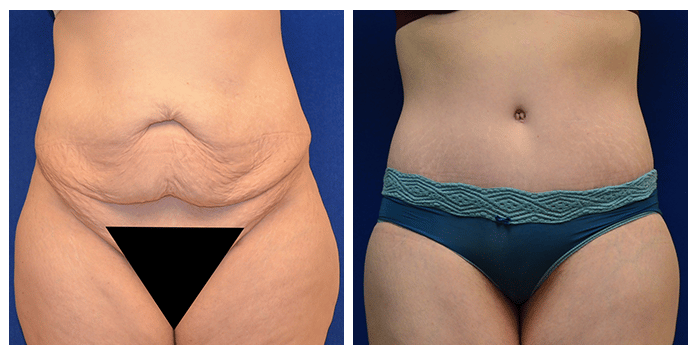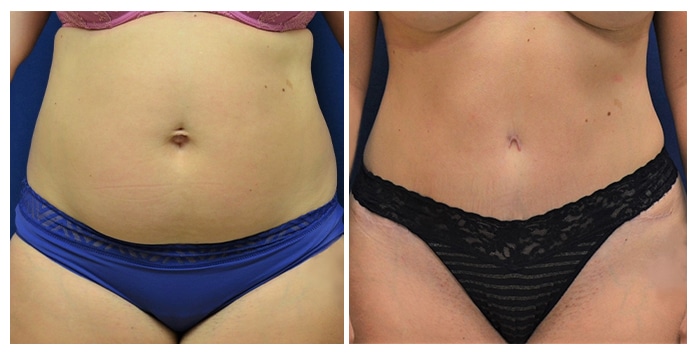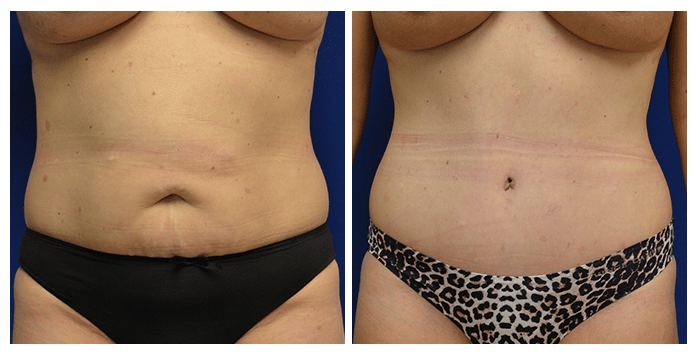Tummy Tuckin Portland, Oregon
Quick Links ‹
- What is a Tummy Tuck?
- Tummy Tuck Benefits
- Who is a Candidate for Tummy Tuck in Portland?
- Types of Tummy Tuck Procedures
- Tummy Tuck Alternatives
- Preparing for a Tummy Tuck
- The Tummy Tuck Surgery
- ABDOMINOPLASTY RESULTS AND RECOVERY
- Risks of Tummy Tuck
- Tummy Tuck Combination Procedures
- What to Expect From a Tummy Tuck Consultation
- Schedule a Consultation
- Tummy Tuck FAQs
What is a Tummy Tuck?
Excess, sagging skin and stubborn fat around the midsection can cause many individuals to feel self-conscious. A tummy tuck can improve the contour and appearance of the waist by eliminating excess skin and tightening the abdominal muscles.
A tummy tuck, also called abdominoplasty, can also have some medical benefits, especially in women after childbirth. It is a common procedure included in mommy makeovers, lower body lifts, or post-weight loss surgeries.
Tummy Tuck Benefits
A tummy tuck offers a variety of significant benefits for individuals looking to achieve a firmer and flatter abdominal profile:
- Removes excess skin and fat
- Tightens the abdominal muscles
- Improves the overall contour of the midsection
This procedure is particularly beneficial for those who have experienced significant weight loss or pregnancy, as it helps eliminate loose, sagging skin and restore a smoother, more youthful appearance; a tummy tuck can also improve clothing fit.

Who is a Candidate for Tummy Tuck in Portland?
Men and women with sagging abdominal skin and excess fat that is resistant to diet and exercise in the abdominal region are likely good candidates for this surgery. This excess skin and fat could result from conditions and events such as:
- Pregnancy
- Weight Fluctuations
- Aging
- Heredity
As with any cosmetic plastic surgery, tummy tuck candidates should be in good health and be non-smokers, since ongoing nicotine use can affect the recovery process. Dr. Fichadia recommends that patients stop smoking for at least four to six weeks before this major surgery to minimize healing issues.

For women of childbearing age looking into abdominoplasty, Dr. Fichadia recommends waiting until you are finished having children to ensure a long-lasting result. Although you can still bear children after a tummy tuck, a future pregnancy will reverse some of the positive effects of a tummy tuck. Patients who want to have kids in the future may still choose liposuction to improve their curves while saving the tummy tuck for the future.
Types of Tummy Tuck Procedures
There are a number of different ways to contour the midsection. During your tummy tuck consultation, Dr. Fichadia can recommend the right one for you based on your goals, condition, and anatomy.

FULL TUMMY TUCK
A full tummy tuck, also known as a traditional tummy tuck, is the most popular form of abdominoplasty in Portland, Oregon. A horizontal incision is made in the area above the pubis from hip to hip, through which excess skin is removed, muscles are tightened, and abdominal fat is removed. If a patient has stretch marks in the treatment area, these may be removed through surgical excision for a more even appearance of the abdomen.
An incision around the belly button is also used to relocate it to a more aesthetically pleasing position. Diastasis recti, separated abdominal muscles, can be fixed with a tummy tuck. When additional waistline contouring is desired, tummy tucks can also be combined with liposuction.
MINI TUMMY TUCK
For patients where the majority of excess skin is below the belly button area, a mini tummy tuck Portland is a great option. It is less invasive than a full tummy tuck, with a shorter incision. This means the recovery is shorter and more comfortable than a standard tummy tuck. This is not an option for everyone, as tummy tuck patients who need muscle tightening or repair of abdominal muscle separation will need one of the more invasive (and effective) tummy tuck procedures.
EXTENDED TUMMY TUCK
An extended tummy tuck is an expanded form of tummy tuck procedure with longer incisions that can also address concerns on the outer thighs. An extended tummy tuck is often an effective treatment for patients who wish to refine their figures following substantial weight loss. This procedure is ideal for patients who have a significant amount of excess fat and skin in the abdomen, upper hip, and lower back regions. Repair of the stomach muscles is done just like with a regular tummy tuck. Liposuction is often used to remove excess fat around the lower body as well.
FLEUR-DE-LIS TUMMY TUCK
If a patient (typically after significant weight loss) has excess skin in both the vertical and horizontal dimensions, a fleur-de-lis or vertical abdominoplasty may be required. In this procedure, a vertical incision will be needed in addition to the traditional horizontal one in order to access and remove a large amount of skin. Because of this, the scar after recovery will be more visible than a traditional abdominoplasty and may be associated with wound healing problems.
Tummy Tuck Alternatives
While a tummy tuck provides dramatic results, there are several alternatives for individuals seeking less invasive options. A consultation with a plastic surgeon can help determine the most suitable approach based on individual goals and body condition:
Liposuction
Liposuction is a surgical procedure to remove excess fat deposits from specific body areas, such as the:
- Abdomen
- Thighs
- Hips
- Arms
Liposuction involves using a thin tube called a cannula, which is inserted through small incisions to suction out the fat. Liposuction can effectively contour and reshape areas resistant to diet and exercise, providing a slimmer and more proportionate appearance.
Body Contouring
Body contouring encompasses a variety of procedures aimed at reshaping and refining the body’s overall appearance. These procedures can address excess skin, stubborn fat, and other aesthetic concerns resulting from significant weight loss, aging, or pregnancy. Standard body contouring treatments include:
- Tummy tucks
- Liposuction
- Thigh
- Arm
- Body lifts
Each procedure is tailored to the individual’s unique needs and goals, helping to achieve a more balanced, youthful, and aesthetically pleasing physique.
Preparing for a Tummy Tuck
Preparing for a tummy tuck involves several important steps to ensure a safe and successful outcome. In the months leading up to surgery, patients should maintain a stable weight, refrain from smoking, and follow a healthy diet and exercise regimen. Arranging time off work and assistance during recovery is also crucial. Pre-operative instructions must be carefully followed, such as avoiding certain medications and fasting before surgery.
The Tummy Tuck Surgery
Dr. Fichadia performs tummy tuck surgery under general anesthesia in an accredited ambulatory surgery center. Once anesthesia is administered, the predetermined incision is made to gain access to the underlying tissues of the abdomen. Excess skin and fat are removed and the abdominal muscles are tightened with sutures.
This procedure can reposition and strengthen the abdominal muscles if they have become separated. This is most commonly seen after pregnancies, but body weight fluctuations can also cause it.
Once the desired changes are made, the skin is pulled downward and tightened, and any excess is trimmed away. The incisions are then closed and dressed for recovery, and any drains that are needed will be put in place. Dr. Fichadia uses long acting pain medicine known as Exparel during your tummy tuck, which gives you pain relief for 48 hours following surgery.
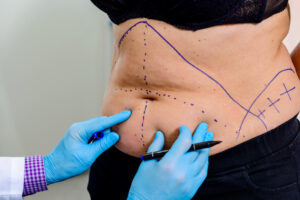
ABDOMINOPLASTY RESULTS AND RECOVERY
Our entire team is ready to support you as you undergo your tummy tuck surgery. We will prepare you for recovery by giving you detailed information on what to expect in the days and weeks following your procedure.
Following the tummy tuck procedure, patients will need to wear a compression garment to help reduce swelling and support the abdomen as it heals. You can expect some swelling and discomfort, which can be managed with prescription or over-the-counter medications.
Most tummy tuck patients return to work, school, or regular at-home tasks after two to four weeks of downtime, depending on the type of work and extent of the procedure. Heavy lifting (over 10 lbs) and strenuous activity should be avoided for six to eight weeks. It is important that patients ease back into their normal routine gradually for the best results.
Your results will continue to improve and refine over the months after surgery. Because the incision for most tummy tuck procedures is placed below the bikini line, in most cases, the resulting scar is hidden in a bikini or low-rise pants, allowing women to have full flexibility with their wardrobe choices. During your consultation, Dr. Fichadia can discuss your options for scar management if you feel you will be prone to excess scarring.

Risks of Tummy Tuck
A tummy tuck carries certain risks and potential complications, like any surgical procedure. These can include:
- Infection
- Bleeding
- Poor wound healing
- Scarring
- Adverse reactions to anesthesia
- Blood clots
- Nerve damage
- Changes in skin sensation
While serious complications are rare, patients must discuss these risks with Dr. Fichadia and follow all pre- and post-operative care instructions to ensure a smooth recovery.
Tummy Tuck Combination Procedures
A tummy tuck can be effectively combined with other surgical procedures to address multiple aesthetic concerns in one operation. These combined approaches can provide comprehensive improvements and a more harmonious overall appearance:
Breast Lift
A breast lift is designed to raise and firm the breasts by removing excess skin and tightening the surrounding tissue. This procedure can address sagging and restore a more youthful breast contour, often after pregnancy, breastfeeding, or significant weight loss.
Mommy Makeover
A mommy makeover is a customized combination of cosmetic procedures designed to restore and enhance a woman’s body after pregnancy and childbirth. This typically includes a tummy tuck, breast lift or augmentation, and liposuction, though it can be tailored to address specific concerns such as stretch marks or vaginal rejuvenation.
Buttock Enhancement
Buttock enhancement procedures aim to improve the shape, size, and contour of the buttocks. Buttock enhancement can enhance overall body proportions, youthful appearance, and self-confidence.
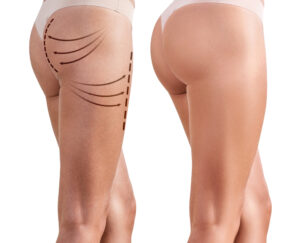
What to Expect From a Tummy Tuck Consultation
During a tummy tuck consultation, Dr. Fichadia will thoroughly evaluate the patient’s medical history, physical condition, and aesthetic goals. Patients will have the opportunity to ask questions, express concerns, and discuss their desired outcomes. The consultation is essential in developing a personalized surgical plan and ensuring the patient is well-informed and comfortable with their decision.
Schedule a Consultation
For people looking for a highly effective way to slim and firm up their abdomen, a Portland abdominoplasty can be a great option. To learn more about this procedure and to create your personalized surgery plan, schedule a consultation with board-certified plastic surgeon Dr. Hetal Fichadia today. Contact us by calling (503) 488-2344 or filling out our online form.
Tummy Tuck FAQs
How much does it cost for a tummy tuck?
The cost of a tummy tuck can vary based on many different factors, including: Anesthesia, Facilities, Materials, Surgeon’s fees, Appointments. It’s important to understand that your tummy tuck surgery cost should not be prioritized over your plastic surgeon’s skill and credentials. One effective way to determine this is to look at your board certified plastic surgeon’s tummy tuck before and after photos (view Dr. Fichadia’s tummy tuck pictures) or tummy tuck surgery videos. We accept CareCredit and can give you a full estimate of your associated costs during a consultation.
What is the difference between liposuction and tummy tuck?
Liposuction is a separate, minimally-invasive technique that can be performed on many areas of the body. It does not involve removal of skin, or repair of muscle. It is reserved for patients with limited areas of stubborn fat that don’t need removal of excess skin. Generally, patients that lack skin elasticity or have excess require surgical correction through a tummy tuck procedure. Additionally, liposuction does not address the muscle separation like a tummy tuck does.
What medical benefits does a tummy tuck offer?
The American Society of Plastic Surgeons has published the results of studies showing a decrease in both back pain and urinary incontinence in postpartum women that underwent tummy tuck surgery. This is attributed to the muscle tightening (sometimes called rectus plication) that increases ability of the abdomen to support the upper body. Over the course of pregnancy or weight gain, these muscles can become stretched and ineffective, meaning they require surgical correction. Additionally, some patients that suffer from reoccurring ventral hernias can benefit from a strengthened abdominal wall. It should be noted that male tummy tuck patients can benefit from these techniques as well.
Do non surgical techniques work?
Although non-surgical fat reduction procedures or tummy tuck belts (sometimes marketed as a non-surgical tummy tuck or tummy tuck alternative) can improve the profile of the abdomen underneath clothing, these techniques can’t remove excess skin or repair stretched muscles. These tummy tuck systems sometimes include compression garments and tummy tuck creams which generally don’t produce results that are surgical-grade.`
When should I get a tummy tuck?
If you have excess loose skin and fat on the abdomen, then a tummy tuck is a great way to improve the contours of the stomach. It is important that you are at or near your desired weight and can retain that weight before getting a tummy tuck. The tummy tuck requires a lengthy recovery so it should be done during a time when you can take off work to recover.
What is a tummy tuck and how much does it cost?
A tummy tuck is a surgical procedure done to remove excess skin and fat on the abdomen, tighten up the tissues, and fix any weakened muscles for a slimmer abdominal appearance. The surgery is highly individualized so the cost will vary between patients. During your consultation with Dr. Fichadia, she will give you your estimated tummy tuck cost.
How many sizes do you lose with a tummy tuck?
A tummy tuck is not a weight loss surgery, patients should be in good health and at a stable weight prior to their tummy tuck. However, since the tummy tuck removes excess skin and fat patients typically see a change in their size afterward. Most patients notice a change of 2 to 3 clothing sizes.
Is it worth getting a tummy tuck?
The tummy tuck is the most effective method of removing fat, skin and tightening the muscles in the abdomen. Although the tummy tuck requires a lengthy recovery, the results are long-lasting and dramatic.
How much weight can you lose having a tummy tuck?
Patients who have weight to lose should not get a tummy tuck. It is important that you are within 10 pounds of your ideal weight and able to sustain that weight in order to get a tummy tuck. The amount of weight lost afterward will depend on how much excess skin and fat you have to remove.
Can I walk after tummy tuck?
Yes! In fact, Dr Fichadia encourages her tummy tuck patients to walk the same day, and take brief walks around the home every few hours to improve circulation and reduce the risks of blood clots.
Are tummy tucks dangerous?
There are risks that come with any surgery. The best way to mitigate these risks is by selecting a board certified plastic surgeon with experience in performing tummy tuck surgery. Dr. Fichadia will review any and all associated risks and ways to mitigate them prior to surgery. Patient safety is priority.
Can a tummy tuck cause stomach issues?
Muscles are tightened during a tummy tuck and it increases the abdominal pressure, sometimes causing heartburn type symptoms. These symptoms are usually temporary as the stomach relaxes to a new equilibrium with time. Dr Fichadia recommends taking Zantac or prilosec for bothersome symptoms in the short term.
Can you get a tummy tuck if youre obese?
Tummy tuck is not a weight loss surgery, and is recommended in patients who are close to their ideal or baseline body weight.
Do you get a scar from a tummy tuck?
With any and every surgery, comes a scar. However, there are steps you can take during your recovery to lessen its appearance over time, like silicone treatments, scar massage, and sun protection. These options will be discussed with each patient throughout their care.
Do you have to be skinny to get a tummy tuck?
Dr Fichadia recommends that patients be close their ideal body weight for a tummy tuck. For a better aesthetic outcome, a BMI of 30 or under is ideal.
Does a tummy tuck tighten muscles?
Yes, the core muscles (which are often separated in pregnancy) are tightened during a tummy tuck.
Who is a good candidate for tummy tuck?
Patients who benefit most from a tummy tuck are those with loose, excess skin on the abdomen because of pregnancy or weight loss. A tummy tuck can also address stubborn fat and stretched abdominal muscles.
When can I wear regular clothes after tummy tuck?
Most of the s
How long will a tummy tuck last?
A tummy tuck will last if you maintain a stable weight and healthy lifestyle. Future pregnancies or weight gain can compromise your results, which may benefit from a revision procedure.
Will a tummy tuck make my stomach flat?
A tummy tuck can reduce lax skin and stubborn fat that can contribute to the appearance of a rounded stomach. Muscle stretching and separation can also exacerbate this concern, and a tummy tuck can repair and reposition these muscles for a flatter, more toned look. nThere is something to be said about visceral fat which is the fat that lines our organs for protection, this is a type of fat storage not impacted by tummy tuck surgery. However, most bothersome fat tends to be subcutaneous which is more superficial and tends to be pinchable.
How dangerous is a tummy tuck?
Tummy tucks have been done for several decades with great outcomes. All major surgery comes with some inherent risks, which can be reduced with careful planning before and after surgery, and a tummy tuck is no exception. Dr Fichadia works with board certified anesthesiologists in an accredited surgery center to ensure that your health is in the best hands.
Do tummy tucks work?
Yes, they have been done for several years with great results.
How are tummy tucks done?
Tummy tucks are performed under general anesthesia. It includes an incision across the abdomen, allowing access to the tissues underneath. Excess fat and skin can be removed, and the underlying muscles can be repaired and strengthened with sutures.
How long do you wear a binder after surgery?
Dr Fichadia recommends wearing a binder for a total of 6 weeks. If its uncomfortable, you may switch into a shapewear such as spanx with high waist.
What do you eat after tummy tuck?
You can slowly resume your regular diet after waking up from anesthesia. Eating healthy with lean protein, and drinking plenty of fluids will help your recovery.
Do men get tummy tucks?
The tummy tuck is a popular option for men who experienced weight loss and are looking to get rid of excess skin and stubborn fat. It can help achieve better definition in the stomach and create a flatter, more masculine look.
Can you get pregnant after tummy tuck?
A tummy tuck will not prevent you from getting pregnant in the future. A pregnancy can, however, can compromise your results. It’s recommended that you be finished having children before opting for a tummy tuck.
How long does a tummy tuck surgery take?
Anywhere from 3.5-4.5 hours based on addition of other ancillary procedures such as flank liposuction.
Dr. Fichadia is a double board-certified, comprehensively trained plastic and reconstructive surgeon. She completed general surgical training at St Elizabeth’s Medical Center, an affiliate of Tufts University School of Medicine in Boston, MA, and subsequently completed a highly competitive plastic surgery program at Oregon Health and Science University in Portland, OR. She has presented research from her time in Boston and Portland at national and international surgical meetings such as Clinical Congress of the American College of Surgeons and annual meeting of American Society of Plastic Surgery.
 (503) 488-2344
(503) 488-2344


